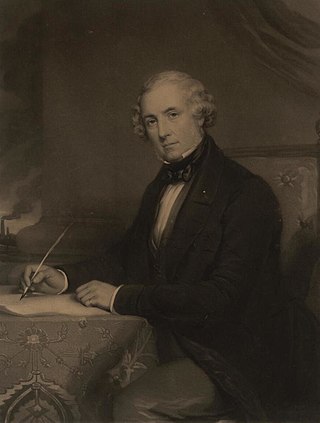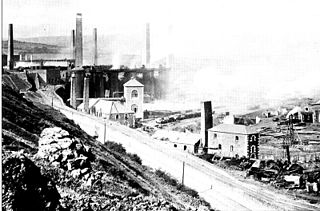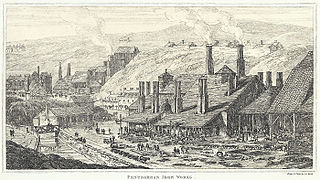
Henry Austin Bruce, 1st Baron Aberdare, was a British Liberal Party politician, who served in government most notably as Home Secretary (1868–1873) and as Lord President of the Council.

Merthyr Tydfil is the main town in Merthyr Tydfil County Borough, Wales, administered by Merthyr Tydfil County Borough Council. It is about 23 miles (37 km) north of Cardiff. Often called just Merthyr, it is said to be named after Tydfil, daughter of King Brychan of Brycheiniog, who according to legend was slain at Merthyr by pagans about 480 CE. Merthyr generally means "martyr" in modern Welsh, but here closer to the Latin martyrium: a place of worship built over a martyr's relics. Similar place names in south Wales are Merthyr Cynog, Merthyr Dyfan and Merthyr Mawr.

Sir Josiah John Guest, 1st Baronet, known as John Josiah Guest, was a Welsh engineer, entrepreneur and politician.

The A465 is a trunk road that runs from Bromyard in Herefordshire, England to Llandarcy near Swansea in South Wales. The western half is known officially as the Neath to Abergavenny Trunk Road, but the section from Abergavenny to the Vale of Neath is more commonly referred to as the Heads of the Valleys Road because it links the northern heads of the South Wales Valleys. Approximately following the southern boundary of the Brecon Beacons National Park, the Ordnance Survey Pathfinder guide describes it as the unofficial border between rural and industrial South Wales. The A465 provides an alternative route between England and the counties in South West Wales and to the ferries to Ireland.

The South Wales Valleys are a group of industrialised peri-urban valleys in South Wales. Most of the valleys run north–south, roughly parallel to each other. Commonly referred to as "The Valleys", they stretch from Carmarthenshire in the west to Monmouthshire in the east; to the edge of the pastoral country of the Vale of Glamorgan and the coastal plain near the cities of Swansea, Cardiff, and Newport.

Merthyr Tydfil and Rhymney is a constituency represented in the House of Commons of the UK Parliament since 2015 by Gerald Jones of the Welsh Labour Party. It was established for the 1983 general election.

The Cyfarthfa Ironworks were major 18th- and 19th-century ironworks in Cyfarthfa, on the north-western edge of Merthyr Tydfil, in South West Wales.

The Dowlais Ironworks was a major ironworks and steelworks located at Dowlais near Merthyr Tydfil, in Wales. Founded in the 18th century, it operated until the end of the 20th, at one time in the 19th century being the largest steel producer in the UK. Dowlais Ironworks were the first business to license the Bessemer process, using it to produce steel in 1865. Dowlais Ironworks was one of the four principal ironworks in Merthyr. The other three were Cyfarthfa, Plymouth, and Penydarren Ironworks. In 1936 Dowlais played a part in the events leading to the abdication crisis of Edward VIII, when the King visited the steelworks and was reported as saying that "these works brought these men here. Something must be done to get them back to work", a statement which was seen as political interference. The steelworks finally closed in 1987.

Merthyr Vale is a linear village and community in the Welsh county borough of Merthyr Tydfil. Lying on the A4054 road it is on the east bank of the River Taff.

Penydarren Ironworks was the fourth of the great ironworks established at Merthyr Tydfil in South Wales.
Merthyr Tydfil was a parliamentary constituency centred on the town of Merthyr Tydfil in Glamorgan. From 1832 to 1868 it returned one Member of Parliament (MP) to the House of Commons of the Parliament of the United Kingdom, and in 1868 this was increased to two members. The two-member constituency was abolished for the 1918 general election.

The Ffos-y-fran Land Reclamation Scheme is a major opencast coaling operation to the north-east of Merthyr Tydfil in South Wales. The contracted excavator/reclaiming company is Merthyr Ltd, which is owned by Gwent Investments Limited, a privately-owned family business based in South Wales. The scheme development is the last part of the East Merthyr Reclamation scheme, and will extract 10 million tonnes of coal over 15 years, with the intention of using part of the revenue to redevelop the current former industrial workings into residential and recreational use.

Dowlais is a village and community of the county borough of Merthyr Tydfil, in Wales. At the 2011 census the electoral ward had a population of 6,926, The population of the Community being 4,270 at the 2011 census having excluded Pant. Dowlais is notable within Wales and Britain for its historic association with ironworking; once employing, through the Dowlais Iron Company, over 7,000 people, the works being the largest in the world at one stage.

The A4060, also known as the East of Abercynon to East of Dowlais Trunk Road, is a trunk road in Wales.
Penydarren is a community and electoral ward in Merthyr Tydfil County Borough in Wales.

Merthyr Tydfil County Borough is a county borough in the south-east of Wales. In mid 2018, it had an estimated population of 60,183 making it the smallest local authority in Wales by both population and land area. It is located in the historic county of Glamorgan and takes its name from the town with the same name. The county borough consists of the northern part of the Taff Valley and the smaller neighbouring Taff Bargoed Valley. It borders the counties of Rhondda Cynon Taf to the west, Caerphilly County Borough to the east, and Powys to the north.

Charles Wilkins of Merthyr Tydfil, Glamorganshire, was a prolific writer of historical accounts of Wales and its industries. He produced pioneering reference works on the histories of Merthyr Tydfil and Newport; the coal, iron, and steel trades of South Wales; and Welsh literature. He was also founding editor of The Red Dragon: The National Magazine of Wales.

Bethania, Dowlais was a Welsh Independent, or Congregationalist, chapel in South Street, Dowlais, near Merthyr Tydfil, South Wales. The cause was established in 1824 and the chapel rebuilt on several occasions in the nineteenth century. The present chapel dates from 1895 but was vastly enlarged and re-modelled in 1910. The building is Grade II listed.
Dowlais Central railway station served the village of Dowlais, Glamorgan, Wales, from 1869 to 1960 on the Brecon and Merthyr Tydfil Junction Railway.

Dowlais Top railway station served the village of Dowlais, Glamorgan, Wales, from 1867 to 1962 on the Brecon and Merthyr Tydfil Junction Railway.

















